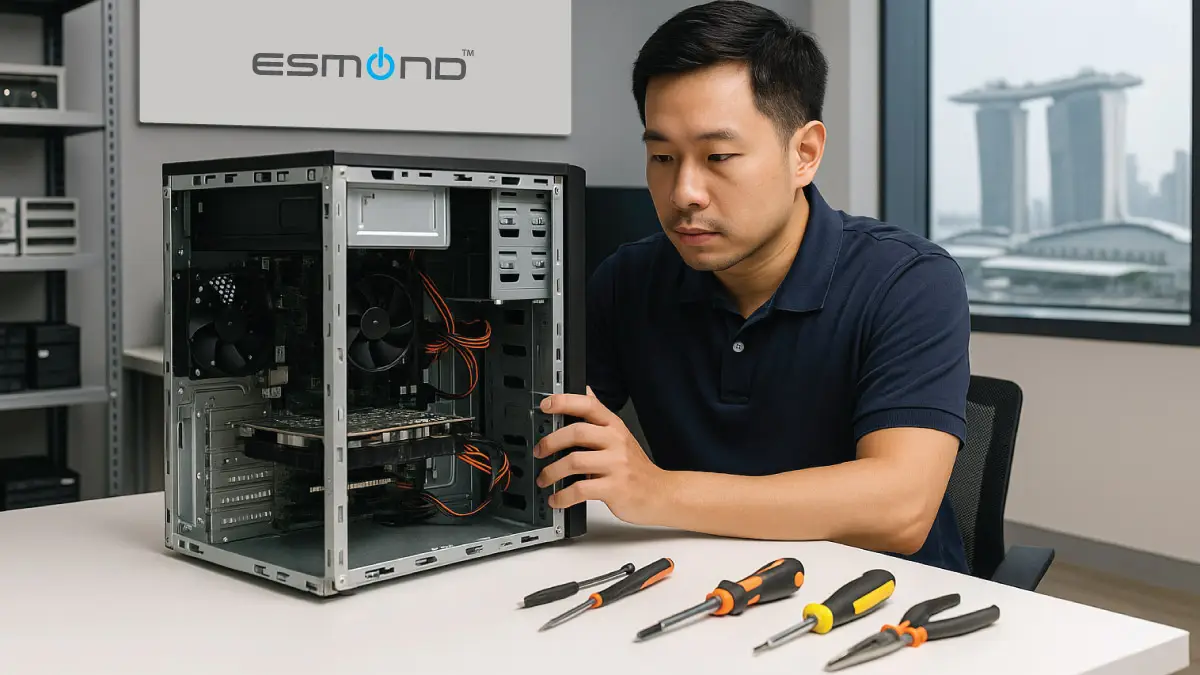
Desktop computers remain essential tools for many Singapore homes and offices, but they are not without their quirks. There are many situations where you might need desktop repair Singapore services, from sudden shutdowns in the tropical heat to mysterious screen issues. Understanding common desktop problems (and knowing when to seek desktop repair Singapore help) can save time and frustration. This article offers practical solutions for frequent PC issues and highlights Esmond Service Centre’s expertise. Esmond Service Centre – a trusted local expert in desktop repair Singapore – has over 10 years of repair experience. They’ve seen virtually every PC issue and successfully resolved it. Read on to learn how to fix common desktop woes and keep your computer running smoothly.
Problem: You press the power button on your desktop PC and nothing happens – no lights, no fan noise, and no display. This scenario can occur at home or in the office and often causes panic (leading to frantic calls to a desktop repair Singapore technician).
Possible Causes: Most often, the PC isn’t getting power due to something simple like an unplugged cable or an off switch (at the wall or on the PSU itself). In rarer cases the Power button or motherboard has failed, cutting off all power.
Step-by-Step Solution:
Verify power connections: Check that the power cable is firmly plugged into both the PC’s power supply and the wall outlet (or surge protector). Ensure the wall switch (if any) is on. If using a power strip, confirm it hasn’t tripped. You can test the outlet by plugging in another device (like a lamp) to rule out a dead socket.
Check the power supply switch: Nearly all desktop PCs have a rocker switch on the back of the case where the power cord plugs into the PSU. Make sure this switch is in the “|” (on) position – the PC will not power up otherwise.
Consider hardware failure: If all external connections are correct and the machine still won’t power on, the issue may lie inside. The power supply unit (PSU) itself or the motherboard could be defective. At this point, it’s best to have a professional diagnose it. A dead PSU or fried motherboard will need replacement, which is best handled by a desktop repair Singapore professional.
Problem: Your desktop computer becomes very hot during use, sometimes accompanied by loud fan noise, sluggish performance, or even sudden shutdowns. In Singapore’s warm, humid climate, overheating is a common desktop issue – in fact, it’s one of the top problems seen by desktop repair Singapore technicians – and it can strike both home PCs and office workstations. One minute you’re working, and the next the PC might freeze or power off to protect itself from heat.
Possible Causes: Inadequate cooling allows heat to build up. Dust blocking air vents, broken or slow fans, dried thermal paste, or even a stuffy environment can cause a desktop to overheat. Over time, this excessive heat can lead to crashes and hardware damage.
Step-by-Step Solution:
Inspect and clean fans: Unplug the computer, open the case, and check all cooling areas. Dust buildup is the enemy of cooling. Use compressed air (or a soft brush) to gently clean out dust from fans, heat sinks, and vents. Pay special attention to the CPU fan and power supply vents. Removing dust allows air to flow properly and cool the system.
Improve airflow: Ensure the PC isn’t tucked into a cramped space. Give it a few inches of clearance on all sides so that hot air can escape. If the desktop is under a desk or in a cabinet, consider moving it into the open or improving ventilation (for example, by opening the cabinet door while the PC is running). In an office, avoid stacking books or papers against the case vents. Cooler surroundings help a lot.
Verify fan operation: Power the PC back on and observe the fans. Are all fans spinning? Check the CPU fan, case fans, and power supply fan. If any fan isn’t working, that component should be replaced immediately. A non-spinning or weak fan will cause rapid overheating. After cleaning, you should also notice the fans running more quietly and efficiently.
Professional check-up if needed: If your desktop still overheats or shuts down after you’ve cleaned it and ensured proper airflow, there may be deeper issues (for example, a failing cooling fan, bad thermal paste, or sensor problems). In this case, consulting a desktop repair Singapore specialist is wise. Experts can thoroughly clean internal components, reapply thermal paste to the CPU if necessary, or replace malfunctioning cooling hardware to get your PC running cool again.
Problem: You’ve powered on your desktop – you hear fans spinning and perhaps see lights – but nothing appears on the monitor (just a black screen or a No Signal message). This no-display scenario is frustrating and often leads users to suspect the worst. Often, though, the fix is simple and doesn’t require a trip to a desktop repair Singapore shop.
Possible Causes: Usually it’s either a display problem or the PC failing to start correctly. The monitor might be off or set to the wrong input, or the video cable could be loose or bad. It could also be an internal hardware fault – for example, loose RAM or a graphics card issue could prevent the system from properly booting (often with beep code errors).
Step-by-Step Solution:
Check monitor & cables: Ensure the monitor is powered on and set to the correct input source (HDMI, DisplayPort, VGA, etc.). Next, verify the video cable is firmly connected to both the PC and the monitor. An improperly plugged or loose cable is a very common reason for “no signal” issues.
Test with another monitor or cable: If possible, plug your desktop into a different monitor or use a different video cable. This will identify if the original monitor or cable is at fault. For instance, if a second monitor works or a new cable fixes the issue, you’ll know the first component was defective.
Reseat internal components: If you’re comfortable opening the computer, power it off and unplug it. Then, open the case and reseat the RAM – i.e. remove the memory modules and firmly slot them back in. Do the same for your graphics card (if it’s a separate card): remove it and reinsert it securely in its PCIe slot, ensuring any power connectors to the card are reattached. A loosely seated RAM stick or GPU is a common fix for blank screens.
Seek expert help if no change: If you still have no display after checking cables and re-seating parts, the issue might be a more serious hardware failure (such as a faulty graphics card or motherboard). At this stage, engaging a desktop repair Singapore service is prudent. Professionals can test your PC with substitute components to pinpoint the problem and repair or replace the defective part.
Problem: The desktop turns on, but everything is extremely slow. Programs take ages to open, the system might freeze or hang frequently, and overall responsiveness is poor. This is a top complaint from both home users and office workers – a slow PC can derail productivity and raise stress levels. It’s also a frequent reason people seek desktop repair Singapore assistance, although many speed issues can be resolved with some basic upkeep.
Possible Causes: Most often, the PC is bogged down by background processes or malware chewing up CPU and memory. A lack of maintenance (never clearing temp files, for example) also plays a role, often leading users to seek desktop repair Singapore help for sluggish PCs. Hardware limitations like too little RAM or an old, slow hard disk can further make everything feel sluggish.
Step-by-Step Solution:
Close unnecessary programs: Press Ctrl+Shift+Esc to open the Task Manager on Windows (or use Activity Monitor on a Mac). Look at what’s consuming your CPU and RAM. If applications you don’t need are running in the background (for example, a web browser with many tabs, or software updaters), close them. Ending tasks that hog resources will immediately free up memory and processing power.
Check for malware: Run a full system scan using a reliable antivirus or anti-malware tool. Malware is a common culprit for slow PCs – viruses or spyware can silently use up your CPU, memory, and disk, making everything else crawl. Removing any found threats can dramatically speed up your computer if it was infected.
Free up disk space and update: Delete unnecessary files and programs to ensure your disk (especially the C: drive or system drive) isn’t full. If you use a hard disk (HDD), run Disk Defragmenter to organize files. Also, install any pending system updates, as these can sometimes improve performance. A cleaner, up-to-date system will run more efficiently.
Professional tune-up: If you’ve tried the above steps and your desktop is still dragging its feet, you might be dealing with deeper issues (like failing hardware or an operating system that’s corrupted from years of bloat). It could be time for an expert look. A professional desktop repair Singapore service can perform advanced diagnostics – for example, testing if your hard drive is failing or if you need a RAM upgrade – and do a thorough cleanup or hardware upgrade. This kind of tune-up can revive a sluggish PC back to speed.
In this guide, we explored solutions for power failures, overheating, display issues, and slow performance. The takeaway is that many desktop problems have simple fixes – from checking cables and cleaning out dust to disabling heavy software – that anyone can try. However, it’s also important to know when to seek professional help. Stubborn hardware failures or complex software glitches are best handled by experts. Singapore’s tech community has a reliable ally in Esmond Service Centre for those tougher desktop repair Singapore problems. By combining DIY fixes with professional desktop repair Singapore support when needed, you can minimize downtime and extend your PC’s lifespan.
Enjoyed this comprehensive guide? Follow our FaceBook page, Linkedin profile or Instagram account for more expert insights on cutting-edge technology and desktop repair Singapore topics. We regularly post helpful content to empower your tech life. And remember, if you ever need a hand with desktop repair Singapore, the friendly professionals at Esmond Service Centre are just a call away. Whether it’s a minor glitch or a major hardware issue, Esmond Service Centre has you covered. It’s the fastest way to solve any desktop repair Singapore problem!

Reviewed and originally published by Esmond Service Centre on August 6, 2025
Mon to Fri : 10:00am - 7:00pm
Sat : 10:00am - 3:00pm
Closed on Sunday and PH